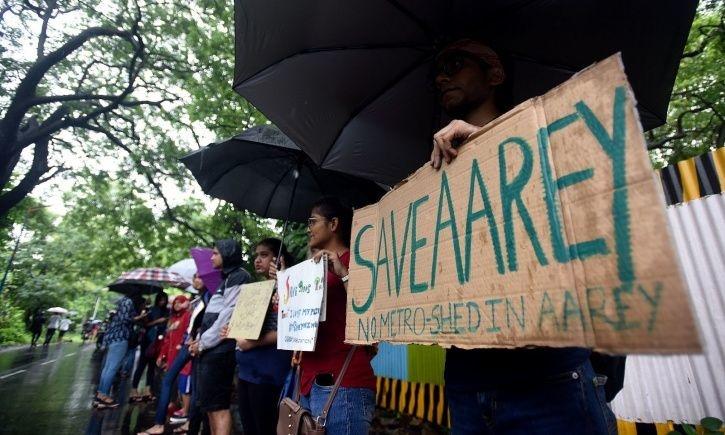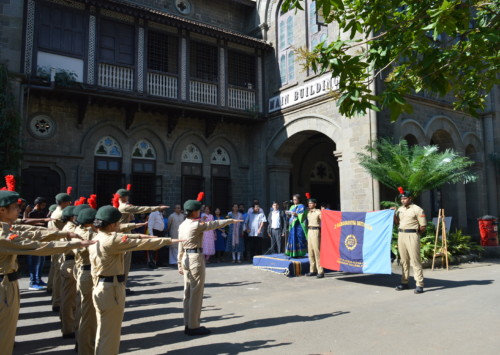Aarey forest: chopping Mumbai’s lungs

Locals protest against the cutting of trees in Aarey Colony to pave way for the Mumbai Metro car shed
The recent midnight raid on an urban forest in Mumbai where the local metro development agency culled over 2,100 trees raises once again the issue of balancing development and environment.
It was in early 1970’s when Chipko movement gained prominence when local residents of Chamoli district in the north Indian state of Uttarakhand (then Uttar Pradesh) started a non violent movement aimed at protecting trees and forests slated for government-backed logging.
Forty five years later an improvised version of the Chipko movement surfaced when people in Mumbai hugged the trees that had been blatantly chopped. The incident took place in the Aarey Milk Colony, located in north-west suburbs of Mumbai. The colony is the site identified for building a metro car-shed for the Mumbai Metro Rail Corridor (MMRC) service connecting north Mumbai with the southern edge of the island city.
In protest against the location of the car-shed inside a dense green area, environmentalists and concerned residents of Mumbai had approached the courts seeking a stay on any development on the land till the case was adjudicated. In a judgement that clearly took the petitioners by surprise,the Bombay High Court ruled that the area was not a forest and cleared the way for felling some 2,600 trees. This resulted in a spiralling war between conservationists and the state authorities that led to several arrests. The situation climaxed on October 4 as the Bombay High Court declined a petition by environmental activists to have the green zone declared a protected forest.
The environmentalists decided to move the Supreme Court of India challenging the ruling of the High Court. However, instead of waiting for the SC, the MMRC authorities used the stealth of the night and using police protection chopped down 2,141 of their intended 2,185 trees in the 33-hectare forest patch. The overnight cutting of trees triggered widespread protests after which Section 144 was imposed on October 5. Following the protests the Mumbai Police arrested 29 protestors. As expected, on October 5, the Supreme Court stayed cutting of any trees but by then it was too late as the MMRC had already done the deed.
The Aarey Milk Colony, an erstwhile government dairy farm, is Mumbai’s second-largest green cover after the Sanjay Gandhi National Park (SGNP). Several years ago, Aarey was broken up to create open ecosystems of grasslands, scrubs, marshes and water bodies, giving refuge to an interesting assemblage of species. The large open para grass fields, proposed for the car shed, are feeding grounds of Munias, Drongos and Egrets. The local streams are home to native fish species, crabs, shrimps and Checkered Keelback water snakes that are protected under the Wildlife Protection Act, 1972 by virtue of being Schedule II species, as per reports by Down to Earth.
“It is quite unique for a city to have areas with such rich biodiversity as Aarey and SGNP. It is home to a variety of flora and fauna right from the top of the predatory chain to rare insects and endangered species,” says Priya Mishra, a key campaigner of Aarey Conservation Group (ACG) while talking to Media India Group. ACG has been spearheading the Save Aarey campaign since 2015.
Bone of contention
Even though the forest is considered to be the lung of the city, the High Court ordered it to be chopped down due to a contentious policy that was eventually used by the government against its own people. The Maharashtra state government has no policy that clearly defines a “forest”. Other states too face similar problems and even the Central government is yet to come up with a proper legal definition. This obvious lapse in the policy has led the government to use it for several development projects and neglect the growing problems to Indian forests.
In its defence, the MMRC has said that the Metro project has been in the works for several years, and now that 90 pc of the trees have been axed, shifting the proposed car shed to a different site will result in a big increase in expenses. However, environmentalists argue that even though the metro can relieve the local people from the daily traffic woes, cutting down the city’s lungs cannot be replaced and will only add to misery of the Mumbaikars (residents of Mumbai).
“The authorities could have been more responsible. Even a person on death sentence has a right to appeal to the Supreme Court and finally a presidential pardon. These trees were killed before the final plea could be made. The HC verdict clearly says that we will not decide on whether Aarey is a forest, you have to get this decided by the SC and NGT. The CJ of Mumbai court also mentioned that he expected the govt to stay their hands till we could approach the SC. This entire exercise of felling the trees was done in such haste to nullify the possibility of a favourable decision for our petition,” says Mishra.
Government failing forests and folks
The government is not only risking the environment by putting biodiversity and floodplain at stake with its decision but also displacing thousands of tribals. The 2005 Maharashtra floods had led to a massive destruction and with more forests being cut down it might lead to many more such episodes of deluge. Aarey is home to over 3,500 families of Warli adivasis and other tribal groups spread over 27 hamlets who now face the fear of being displaced now.
“Protecting Aarey and its remaining open space and trees become critical when seen in the context of the entire city. Mumbai is at the bottom of the world index in terms of open space. It has only three pc of its 458 sq km as open space accessible to the public. Thus Aarey with nearly 800 ha open space goes a long way in providing a much needed natural green area to the public. So all its ecological services of regulating temperatures, noise and dust, acting as a catchment area for Mithi river, increasing groundwater levels, mitigating floods assume a much larger significance because of the paucity of other such areas. Eyeing such a space for more construction instead of realising its contribution to the city’s urban landscape and the physical and emotional health of its citizens is a disastrous step for the city’s future,” says Mishra.
Around INR 9 billion (EUR 110 million) will be spent on the car-shed for the under-construction Colaba-Bandra-SEEPZ Metro Line. The state estimates that over 7.5 million people travel in Mumbai’s suburban trains daily and the upcoming metro will serve as many passengers as suburban rails by 2034 easing the pressure off from the world’s most congested railways. In its defence the MMRC claims significant afforestation has already been done in compensation for the trees cut. However, activists feel that saplings can’t make up for the grown trees that are cut.
“The Maharashtra government needs to wake up to the seriousness of climate change and move quickly in defining, identifying and protecting its forests both big and small. Just throwing around figures of saplings planted is not reassuring. Nor is it enough to carry out these plantation programmes. It has to go hand in hand with conserving its forests,” adds Mishra.
Indian forests are falling down
A recent study report finds that the forests in India are consistently decreasing as across more than 4.6 million hectares of various types of forest in India, particularly in core protected areas. Scientists at Hyderabad’s National Remote Sensing Centre analysed NASA’s MODIS satellite images of India’s forests at eight-day intervals for 15 years (2001 to 2014) and assessed the persistent decreases in greenness. Using an index that determines the amount forest “vigour,” they assessed the seasonal greenness of 14 different forest types: the negative trend of greenness over years, the more degraded and vulnerable the forest.
They found that the highest degradation is in moist deciduous forests (more than two million hectares), especially in the states of Chhattisgarh, Odisha, Maharashtra and Madhya Pradesh. Wet evergreen forests – including those in the Western Ghats and Eastern Himalayas – are also affected, with the major changes observed in Karnataka and Arunachal Pradesh, followed by Kerala and Meghalaya. More than 15 pc of India’s total mangrove forests also showed a decrease in greenness. Nearly 80 pc of these changes occurred in ‘core’ forests like protected areas.
The team also determined the ‘spots’ or areas where the decrease in seasonal greenness were high and spatially contiguous, using statistical analyses. West Bengal was a major hotspot of mangrove degradation. Arunachal Pradesh, Kerala, Karnataka and Meghalaya were hotspots of decreasing greenness of wet evergreen forests while Manipur, Tamil Nadu, Mizoram, Sikkim and Arunachal Pradesh showed degraded montane (high-elevation) wet forests.
The need of the hour for the government is to stop being so indifferent in its policy making decisions regarding every aspect of nature and it is high time when both the central and state governments should come up with solid ground level reforms that can save forests such as Aarey.











